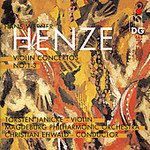
Violin Concertos no 1 - 3
 $54.00
Out of Stock
$54.00
Out of Stock2-4 weeks add to cart
HENZE
Violin Concertos no 1 - 3
Torsten Janicke (violin) / Magdeburg Philharmonie / Christian Ehwald (cond) with Ulf Dirk Madler (baritone)
[ MDG / 2 CD ]
Release Date: Wednesday 1 March 2006
This item is currently out of stock. We expect to be able to supply it to you within 2 - 4 weeks from when you place your order.
"..this very impressively controlled performance from Torsten Janicke and the Magdeburg Philharmonic."
(The Guardian May 2005)
"Hans Werner Henze has written three violin concertos so far, separated in his output by gaps of 23 and 26 years. As you'd expect, they are very different pieces stylistically, and hearing them in succession provides a revealing map of the trajectory Henze's evolution has followed in his orchestral music. However, it's the two most widely separated works here that have the most similarities, suggesting how, in some important respects over the last half-century, he has come full circle.
The four-movement First Concerto dates from 1948, when Henze was still studying with Wolfgang Fortner and developing his own synthesis of neoclassicism and Schoenberg's 12-note method. It was his first work involving a large orchestra and, he later recognised, it was one of the key works in the creation of his personal style. The orchestral writing certainly has a Stravinskian clarity and rhythmic bite, but the harmonic language is recognisably that of the Second Viennese School. Though, with its constant references to tonality, the brand of serialism that Henze followed was much closer to the world of Berg than Schoenberg.
That same Bergian world has characterised much of Henze's music of the last two decades, though in these recent pieces it often lacks the leavening of neoclassical textures so obvious in the First Concerto. The textures of the Third Concerto, first performed in 1997, are generally dense, the harmonies intensely chromatic.
What is characteristic of much of Henze's recent orchestral music too is the literary programme that is attached to the concerto. Its subtitle is "Three Portraits from the novel Doktor Faustus by Thomas Mann", and each of the movements is a sound picture of a character in that novel about modernism and musical creation, whose protagonist is the composer Adrian Leverkühn. So the first movement depicts Esmeralda, Leverkühn's lover who infects him with syphilis, the second, the "child echo", is his nephew, and the third a portrait of his violinist friend Schwerdtfeger, which gives Henze the opportunity for an extrovert, virtuoso finale.
The Second Concerto, which in all other respects seems worlds away from the First and Third, also has literary connections, though they are more explicit. Composed in 1971, and scored for solo violinist, pre-recorded tape, bass-baritone and 33 instrumentalists, the Second belongs to the period in which Henze's music acquired an explicit, political dimension, exemplified by music-theatre pieces such as El Cimarrón and Natascha Ungeheuer, and the opera for Covent Garden, We Come to the River.
There's an element of theatricality about the six-movement concerto too - the spot-lit violin soloist is dressed like Baron Münchausen, while the singer delivers Henze's setting of a poem by Hans Magnus Enzensberger, Hommage à Gödel, that makes reference to Münchausen's fictitious exploits. The result is arguably one of the strongest of Henze's works from the 1970s; certainly that is how it seems in this very impressively controlled performance from Torsten Janicke and the Magdeburg Philharmonic."
(The Guardian May 2005)
Tracks:
Concerto for Violin and Orchestra No 1 (1948)
Concerto for Violin and Orchestra No 3 (1997)
Concerto for Violin and Orchestra No 2 (1971)

